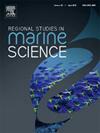Spatial distribution of juvenile corals (Scleractinia) in the coastal and small islands of Sumatra, Indonesia
IF 2.1
4区 环境科学与生态学
Q3 ECOLOGY
引用次数: 0
Abstract
Coral community structure exhibits variation at each stage of its life cycle, but the spatial distribution of corals in early life stages, including from juvenile to adult stages, is not well understood, especially at a larger scale. Spatially, our study compared the genera richness and abundance of juvenile and sub/adult corals at 9 locations and 83 sites along the coast and small islands of western and eastern Sumatra, Indonesia. Field surveys were conducted by recording juvenile corals measuring ≤5 cm in diameter in 1 ×1 m quadrat transects with 6 times randomly at each site, while those with diameters greater than 5–10 cm were categorized as transitional to sub/adult corals. A total of 52 genera from 16 juvenile coral families were recorded and identified, which is higher than the sub/adult level, where a total of 40 genera from 14 families were found. The most common genera came from the Acroporidae (23.0 %), Merulinidae (18.7 %), and Agariciidae (12.7 %) families. The genera richness at the juvenile stage showed variation between locations and regions in western and eastern Sumatra, except between locations in the eastern region, while at the sub/adult stage there was no variation between the western and eastern regions. Abundance at the juvenile stage also showed variation between locations, but did not differ between the western and eastern regions and at locations in the eastern region. In contrast, coral abundance at the sub/adult stage showed differences between locations and regions, but did not show variation at locations in the eastern region. The abundance of juvenile corals was influenced by live coral cover, the presence of herbivorous and corallivorous reef fish, and hard substrates of dead coral, limited to sandy or muddy bottoms and coral rubble. Genera richness was also influenced by live coral cover, but limited by sandy and rubble reef habitats, the cover of other biota such as soft corals, and the presence of herbivorous fish. Variations in water conditions and geomorphological forms between locations on the west and east sides of Sumatra impacted the diversity and abundance of corals in the early stages of life, affecting their success in becoming adult colonies. The transition from juvenile to sub/adult corals emerged as a critical phase in the early life stages of coral for population maintenance and sustainability.
印度尼西亚苏门答腊岛沿海和小岛屿的幼珊瑚(硬皮珊瑚)的空间分布
珊瑚群落结构在其生命周期的每个阶段都表现出差异,但人们对珊瑚早期生命阶段(包括从幼体到成体阶段)的空间分布却不甚了解,尤其是在较大范围内。在空间上,我们的研究比较了印度尼西亚苏门答腊岛西部和东部沿海和小岛屿 9 个地点和 83 个地点的幼体珊瑚和亚成体珊瑚的属种丰富度和丰度。实地调查的方法是在每个地点随机记录 6 次直径小于 5 厘米的幼体珊瑚,记录在 1 × 1 米的四分横断面上,而直径大于 5-10 厘米的珊瑚被归类为过渡珊瑚和亚成体珊瑚。共记录并鉴定了 16 个幼体珊瑚科的 52 个属,高于亚成体珊瑚科的 14 个属的 40 个属。最常见的属来自 Acroporidae(23.0%)、Merulinidae(18.7%)和 Agariciidae(12.7%)科。苏门答腊岛西部和东部不同地点和地区之间在幼体阶段的种属丰富度存在差异,但东部地区不同地点之间存在差异;而在亚/成体阶段,西部和东部地区之间没有差异。幼体阶段的丰度在不同地点之间也存在差异,但在西部和东部地区以及东部地区的不同地点之间没有差异。相反,亚成体/成体阶段的珊瑚丰度在不同地点和区域之间存在差异,但在东部区域的地点没有差异。幼体珊瑚的丰度受活珊瑚覆盖率、食草和食珊瑚礁鱼类的存在以及死珊瑚的硬底质(仅限于沙质或泥质底部和珊瑚碎石)的影响。珊瑚属的丰富度也受活珊瑚覆盖率的影响,但受沙质和碎石礁生境、其他生物群(如软珊瑚)的覆盖率以及食草鱼类的存在的限制。苏门答腊岛西侧和东侧不同地点的水质条件和地貌形态的差异影响了珊瑚生命早期阶段的多样性和丰度,从而影响了它们成为成群珊瑚的成功率。珊瑚从幼体到亚成体/成体的过渡是珊瑚早期生命阶段的一个关键阶段,关系到珊瑚种群的维持和可持续性。
本文章由计算机程序翻译,如有差异,请以英文原文为准。
求助全文
约1分钟内获得全文
求助全文
来源期刊

Regional Studies in Marine Science
Agricultural and Biological Sciences-Ecology, Evolution, Behavior and Systematics
CiteScore
3.90
自引率
4.80%
发文量
336
审稿时长
69 days
期刊介绍:
REGIONAL STUDIES IN MARINE SCIENCE will publish scientifically sound papers on regional aspects of maritime and marine resources in estuaries, coastal zones, continental shelf, the seas and oceans.
 求助内容:
求助内容: 应助结果提醒方式:
应助结果提醒方式:


